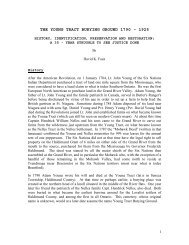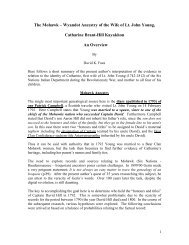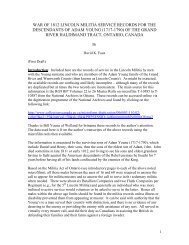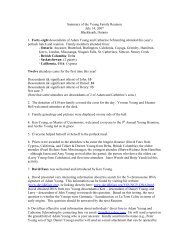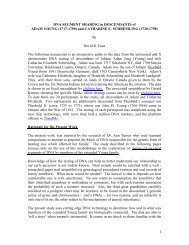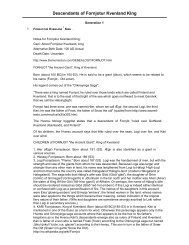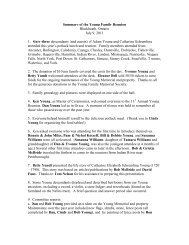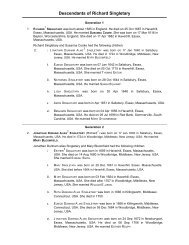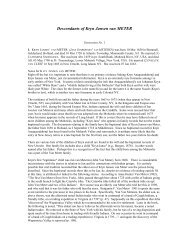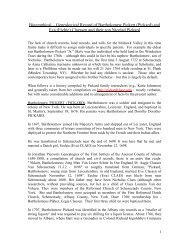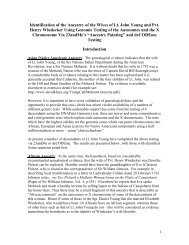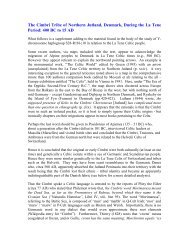lands, as raiders, settlers, or mercenaries, cannot, however, be ruled out. Celtic warbands may have attached themselves to the incursions of the Cimbri in 104 BC andCaesar specifically mentions the arrival in Lerida, in 49 BC, of 6,000 Gauls, includingGallic cavalry, Ruthenian achers, and their families. The contribution of these and otherpossible intruders to Celtiberian culture seems to have been minimal (p.142). In thesame work Cunliffe discusses how the hillfort at Las Cogotas on the edge of the northMeseta in the province of Avila appeared to suddenly emerge as a fortified structureabout 400 BC – at precisely the time of the great La Tene migrations. This observationmay be of particular salience in relation to the finding noted below. The people in thisarea became the Vettones tribe, who emerged at Las Cogotas in the 5 th Century BC. LaTene cultural links are supported by finds of fibulae virtually identical to those seen inEastern France, and antenna-hilted daggers of the “Waldalgesheim Style” seencommonly in the Rhineland. The evidence from Avila suggests that there may have beentwo groups present, where the La Tene element may have been an elite warrior class,buried typically with a full La Tene “package” of grave goods. However, in total, thearchaeological picture cannot be compared with the Celtic migration to Italy or to eastcentralEurope (Lenerz-de Wilde, 1995, p.538). Lenerz-de Wilde interprets the evidenceas a likely migration where a, small number of Celtic immigrants came up the valley ofthe Ebro into the eastern Meseta, there to establish their knowledge of metallurgy, andwere thus rapidly integrated into the local elite. Furthermore that the, radical changes of400 BC must be linked to military operations (p.544). Her interpretation is that theseincoming Celtic groups capitalized on the trading relations that had been in place sinceHallstatt times, and on the trade routes that had been long established. One problem inattaining more precision is that there were no Greek or Roman authors to record thecontemporary events occurring in Spain, and we are left to come up with interpretationsbased largely on archaeological data. Caesar did report that the Berones from the north(presumably Gaul) took part in the migration and that at one time all the people in thearea were known as Keltoi and controlled Spain before the Carthaginians (prior to the 3 rdCentury BC) – see Collis (2003).R-M269 percentages in Spain – While there is considerable regional variation, about 65to 90% of Spaniards are in one clade or another of this haplogroup. Most are expected tobe R-P312/S116* or R-L21* with R-M167 likely being the next most common variety.Alonso et al. (2005) observed 53% R-M269 in Iberians, and of these 2% were R-M153and 2% were R-M167. Among the combined Basque groups, 86% were R-M269, with11% of these R-M153, and 3% being R-M167. The markers M167 and SRY2627 areequivalent, and the former notation will be used here. A sampling of a wide variety ofregions in Spain can be found in Flores et al. (2004).Brion et al. (2004) completed a regional study of northern Spain – Galicia (NW) andCantabria (NE). As is all too typical, the genotyping lacked depth including only 92R7-P*(xR1a,R-M167) and so we must assume that these were R-M269. The results variedquite significantly by microregion. Thus for Galicia, the numbers varied from 39% to65% assumed R-M269; and for Cantabria 40% to 63%. They also measured R-M167which should be added to the above to give the full R-M269 percentages. Here thepercentages for Galicia varied from 0% to 6%; and for Cantabria, 0% to 8%.16
Beleza et al. (2005) published an extensive study of Portugese haplotypes andhaplogroups. 53% were R-M269. Of these 4% were R-M167.R-U152 predictions – It seems evident that R-P312/S116* or R-L21* will predominate inIberia. It is a toss up as to whether R-M269 (apparently scattered widely throughoutIberia) or R-U152 will be the next most frequently occurring subtype. Since relativelyfew from this area have tested it is difficult at this point to come up with anything morespecific. It is possible that some of the Celtiberians, believed to have emigrated from theeast in the 8 th or 7 th Centuries BC are R-U152, and if so, the numbers of Spaniards whoare U152+ could be much larger than anticipated. It is not expected, if the U152+ inSpain is via La Tene migrations, that this haplogroup will make up more than 10% of theR-M269 in that country.It is probable that there was a migration of La Tene Celts from Spain to Portugal, butthere is insufficient information upon which to make any sort of informed estimate. Areasonable guess would be the same percentage as R-M167, in other words less than10%.R-U152 findngs – In a small commercial sample there is one individual from Avila,Spain (in what is known as the Meseta region), others from Cantabria, and another from aCeltic enclave on the Mediterranean coast have been determined to be U152+. There isno data from Portugal to date.IRELAND: There is nothing in the historical or archaeological record that wouldsuggest that Ireland experienced any influx of people during the La Tene expansion. Thefew La Tene artifacts all appear to be locally made and there is nothing else in the recordthat would point to anything other than an indigenous population who adopted some ofthe La Tene cultural “package”, adapting it to fit within their own cultural framework(e.g., Raftery, 1991). In the McEvoy et al. (2004) genetic study of the Celtic origins ofIreland and the Atlantic Façade of Europe, they state, archaeological evidence for largescaleIron Age migrations into the British Isles has been singularly lacking. In Ireland,for example, La Te`ne artifacts are relatively rare and are almost always of indigenousmanufacture rather than of external origin (Raftery 1994), leading archaeologists andhistorians to question the accepted idea of Celtic migration to Ireland (O´ ’Donnabha´ in2000). More generally, Renfrew (1987), among others, proposed that the roots of insularCeltic identity lay within the region in which the Celtic languages were historicallyspoken, in the diffusion of Indo-European speakers into Britain and Ireland with thearrival of the Neolithic in 4000 B.C. They summarize the studies of both mtDNA and Y-DNA and conclude that there is little evidence of any Central European influence, but ashared ancestry across the, Atlantic zone, from Iberia to western Scandinavia, that datesback to the end of the last Ice Age (p.693). There is nothing in the genetic orarchaeological data that would suggest any Hallstatt or La Tene immigration to Irelandand no support for the “Book of Invasions” relating to the Gaels and Fir Bolg (e.g.,James, 1993). La Tene metalwork does not appear until about 250 BC, and this is in a17



